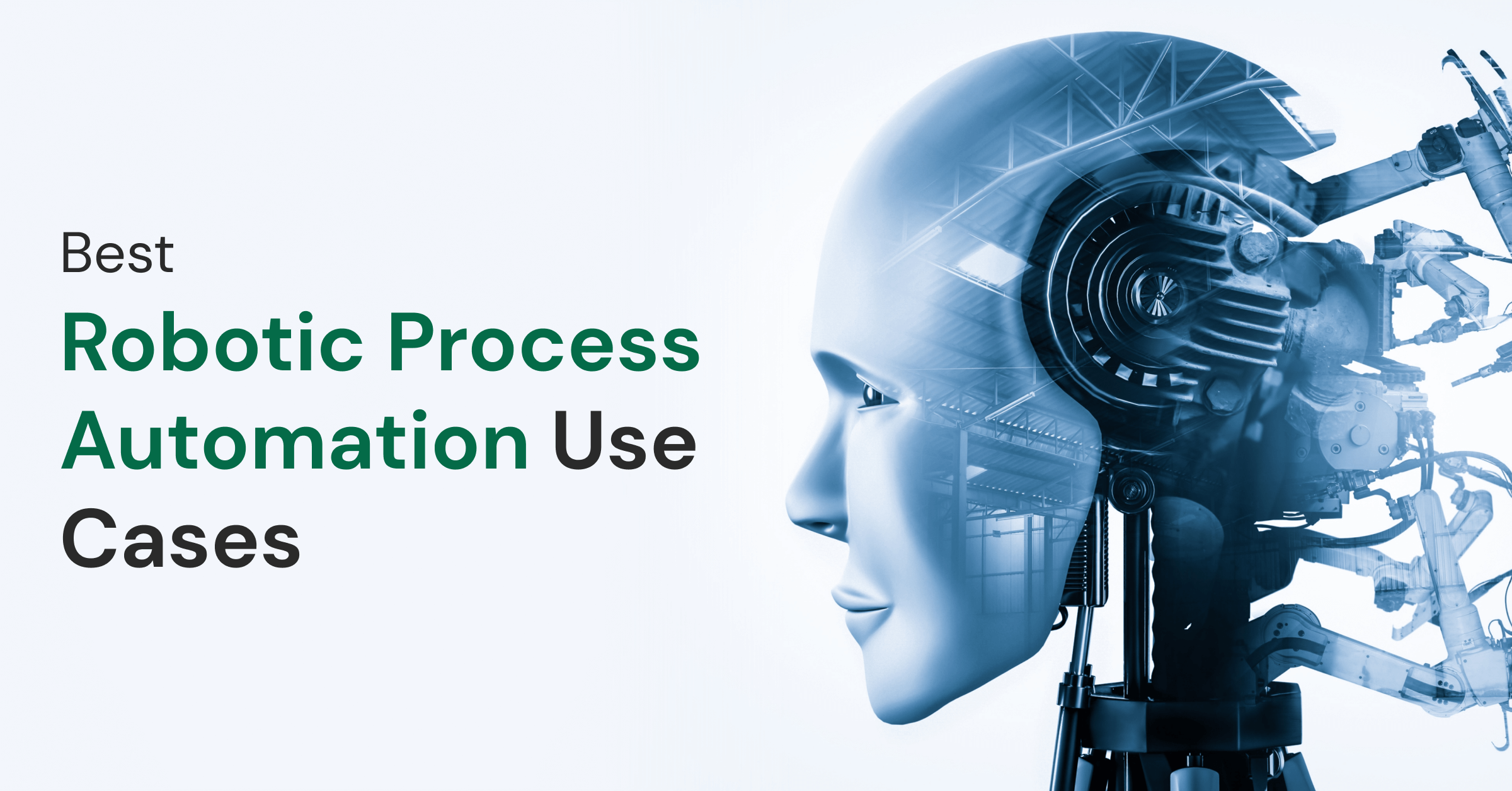
20 Best Robotic Process Automation Use Cases in 2025
Feb 26, 2025 7 Min Read 4350 Views
(Last Updated)
Have you ever thought about how effortless and quick it is to receive your salary every month? Well, what you may not know is that this process is made possible by a powerful method called Robotic Process Automation (RPA).
RPA enables businesses to automate procedures and operations that would typically require human intervention, making the entire process smooth and efficient. The best part is that RPA can be used across various industries, making it a flexible solution that can integrate with different apps and systems.
What’s more, RPA works seamlessly with existing IT infrastructure, eliminating the need for costly new setups. In this blog, we will explore various use cases where organizations can use RPA to automate their work activities, resulting in significant time and resource savings.
Let’s explore the fascinating world of RPA and see how it is transforming businesses across different domains.
Table of contents
- Top 20 Robotic Process Automation [RPA] Use Cases in 2025
- Customer service
- Invoice processing
- Sales orders
- Payroll processing
- Price comparison
- Storing customer information
- HR information processing
- Processing fast refunds
- Recruitment
- Data extraction in different formats
- CRM updations
- Automated testing
- Financial planning and bank statement reconciliation
- Expense management
- Insurance claims handling
- Inventory control
- Lead generation
- Processing of credit cards and mortgages
- Medical billing
- Automation in telecommunications
- Conclusion
- Frequently asked questions
- Where is RPA applied in the real world?
- What are some RPA examples?
- In which industries are RPA mainly used?
- Does RPA have a use case in finance?
- What does RPA have in store for the future?
Top 20 Robotic Process Automation [RPA] Use Cases in 2025
Robotic process automation (RPA) is a powerful tool that can automate an industry’s entire workflow, infrastructure, and other backend procedures, which are typically labor-intensive and time-consuming. This technology is being used across various industries to eliminate the risk of human error and increase efficiency.
RPA software utilizes bots to automate routine operations within software applications that were previously handled by personnel. These RPA tools are designed to save time by eliminating the need for humans to perform monotonous, repetitive, and laborious tasks. If you’re interested in learning more about it, check out our blog post on the best robotic process automation tools used in 2025.
If you’re interested in mastering RPA then you can enroll in GUVI’s course – RPA Design & Development v2.0.
Here is our list of the top 20 most common RPA use cases across different industries, which you can browse below.
1. Customer service
Customers in today’s digital world expect fast responses and practical solutions. With the help of automation, it is viable to give the desired outcomes. Customer service systems that are automated can categorize inquiries and provide fast responses to clients.
The automated system can sort queries into several categories, such as service support, tech support, etc. Sorting ensures that inquiries are routed to the appropriate customer service employee for a prompt response.
There is no need to switch the customer’s call from one executive to another. Several rule-based tasks in customer service can be automated and optimized.
2. Invoice processing
The high invoice processing volume requires repetitive manual procedures, leading to payment delays and errors. Vendors can deliver quality goods/services if payments are made on time. Many obstacles face invoice processing, such as invoices with different formats, the need to aggregate data from numerous sources into a unified financial database system, etc.
Once invoices are received, RPA processes them automatically. OCR can be used to automate the paper-based or text-based invoice format.
RPA can automate data entry, reconciliation errors, and even specific decision-making processes required for invoice processing, reducing the need for human participation. From receipt to payment, RPA can automate the entire process.
3. Sales orders
The challenge of maintaining data integrity across enterprise systems is time-consuming. Sales reps must devote valuable time to entering data into the CRM and ERP systems.
Finance analysts must duplicate the information and enter it into a different approach or module. This could lead to errors, duplication, and a reduction in production.
By automating processes like sales order entry, invoicing, and so on, RPA may conduct sales activities from start to finish. It will help in database maintenance by deleting duplicate data, improving customer experience, and increasing sales personnel satisfaction by removing all time-consuming tasks such as data input to focus on their primary goal of prospecting and creating more revenue.
4. Payroll processing
Payroll processing is a time-consuming, repetitive operation for HR teams in any organization, and it necessitates a high amount of data entry. This could lead to data inaccuracies, payment delays, and employee unhappiness.
Payroll Processing is one of the best RPA use cases. RPA can validate timesheets, load earning, and deductions and verify employee data consistency across several systems.
It can also automate the creation of paychecks and the administration of benefits and reimbursements. RPA may automate payroll processes from beginning to end to eliminate inconsistencies and delays.
5. Price comparison
Businesses frequently need to buy massive amounts to create products and deliver services. The price of these items can impact a company’s profits; corporations always conduct research online before deciding.
Because the research process can be complex and time-consuming, many businesses have started to use RPA. The system can assess product features, quality, and multiple sellers’ prices. Businesses and customers may purchase the best resources at the most competitive cost.
6. Storing customer information
One of the significant use cases of RPA tools is data management. RPA can assist you in sorting, storing, and organizing various types of client data such that it is conveniently accessible.
The system will automatically classify different data types, such as contact information, purchasing history, preferences, and personal information such as birthdays and anniversaries.
Customer service representatives, salespeople, and other staff can see all of the data on the system. It’s unnecessary to enter this data or be concerned about its accuracy manually.
RPA is more accurate and has a reduced margin of error than humans. Information storage is one of the most time-consuming tasks and can be stressful. RPA use can cut repetitive work by roughly 80%.
7. HR information processing
The task of storing and processing HR data is difficult. It takes a long time and can be a frustrating procedure.
A successful company generates many relevant data, which can be tough to filter through and arrange. All of the data that your HR department requires may be collected and organized using the RPA system.
RPA can organize and store information such as employment history, payroll, reimbursements, and level of training. It can handle all of your day-to-day chores, freeing up your HR staff to focus on the human side of things. They can work on enhancing staff productivity and workplace culture, which are not automatable.
8. Processing fast refunds
The speed with which a corporation can process refunds determines its reputation. Customers want a speedy and flawless experience, but that is easier said than done.
Complaints and return requests create a lot of information that can be difficult to filter through. The RPA system handles the situation efficiently and promptly executes the refund. This improves the overall customer experience and boosts your brand’s reputation.
9. Recruitment
Recruitment can also benefit from robotic process automation, which can help to streamline the process significantly. The system may pull resumes from various sources, determine their worth, filter out spam or unwanted applications, and other variables.
This has the potential to fasten the recruitment process significantly. Recruiters will be less stressed, and they will be able to understand each applicant better. RPA can handle 90 to 95 percent of critical recruitment operations like screening, assessing, measuring, onboarding, and administration.
10. Data extraction in different formats
Data can be available in various forms, from editable text to handwritten notes. Data entry pros have difficulty reading the data and entering it into the system. Optical character recognition technology can quickly scan data from various formats and enter it into the system.
The entire procedure can be automated with no loss of data accuracy. RPA is an excellent investment if your company has to collect and store data from several sources.
Employees spend around 10% to 20% of their person-hours on recitative computer tasks such as this one. You may put that time to better use by putting it towards something more useful.
11. CRM updations
Updating interactions and interconnections in CRM takes time and is inefficient yet essential. Salesforce is required to operate as the one source of truth for all customer interactions.
A new class of technologies is emerging that allows businesses to connect their email, call, and other communication data into CRM. You could develop a simple bot to update your CRM records with customer info if you can’t find a viable solution for the CRM system.
12. Automated testing
Testing tools that replicate user interactions evolved into RPA technologies. While software can include testing, it’s also necessary to test from the user’s perspective.
RPA tools are used to automate common test scenarios, and these tests are run after each version to ensure that no new flaws are introduced into the code. More innovative manual tests are required based on the unique feature developed in each new edition.
Automated testing with RPA tools, on the other hand, can make testing more accessible and enhance software quality. Because these tests are typically basic, no-code RPA technologies are excellent in these situations. If you’re interested in gaining industry knowledge, check out our robotic process automation certification course.
13. Financial planning and bank statement reconciliation
Financial planning entails the tedious task of processing and combining financial statements from several departments in a Financial Planning & Analysis (FP&A) system that can be automated.
Using complicated spreadsheets, data was extracted from bank statements to reconcile records and compare them to the company’s records. However, this is a procedure that can be mechanized very readily.
One thing to keep in mind is that rules-based automation may fail if the organization switches banks. After your firm changes financial service providers, it’s best to test the bots’ initial outputs.
14. Expense management
Despite the availability of sophisticated specialized expense management solutions, most businesses continue to rely on antiquated systems that require employees to give detailed information about their spending.
The majority of these facts, such as the amount of the expenditure, the date, and the location, are already available on employee receipts. With an OCR-capable RPA technology, required fields from tickets may be extracted automatically, allowing employees to spend less time on expenses.
This will also spare them from carrying around passes since merely photographing them will enable them to extract relevant data and fill in essential fields on the expense form.
15. Insurance claims handling
Every insurance company’s core business is claims handling. Customer experience and speed are crucial in claims processing since clients file claims during times of hardship.
Multiple reasons cause problems with claims processing and lead to human biases, which can result in losses, customer unhappiness, and a lack of visibility in a critical process.
All of these concerns can be handled with RPA bots. Bots take unstructured data from forms, extract structured data, and process claims according to pre-defined procedures.
This method addresses all of the primary problems associated with manual claims processing. Rules can be altered in response to regulatory changes without the requirement for training, ensuring rapid compliance.
16. Inventory control
RPA bots can help with inventory control by informing you when supply levels are low compared to demand. The bot can read demand planners’ emails and notifications.
To guarantee that the bot correctly pulls up data from emails, emails must adhere to particular style rules.
It can also collect data from emails and automatically update the safety stock details in the ERP. After updating stock levels, they also alert stakeholders involved in the process.
17. Lead generation
Lead generation is an essential component of today’s marketing campaigns. Within a CRM system obtained from outside sources, marketing teams make new entries for potential leads. Some CRM platforms have their data upload capabilities built-in.
The majority of older platforms need users to enter each new lead’s information manually. Consequently, less time is available for other duties, and the risk of error increases.
Users can program software to import data from spreadsheets using RPA, being faster and more accurate than doing it by hand. The employees can again focus on engaging with lead prospects rather than data entry.
18. Processing of credit cards and mortgages
RPA automates background checks and validation based on pre-defined rules and procedures, which speeds up the credit card dispatching process. Banks, like mortgage lenders, must conduct many background checks, including employment and credit history.
The deployment of RPA, which is based on well-defined algorithms, speeds up the entire process. With the introduction of RPA, such frauds can be recognized ahead of time. As a result of automation, banks can now identify and warn accounts that are likely to pose a concern.
19. Medical billing
Use RPA to automate and improve the efficiency of essential procedures in healthcare. Collaborate with internal and external stakeholders, collecting data from each of them. All of these sub-processes should be combined into a single, centralized procedure. Medical billing service providers can pass on significant savings to their healthcare provider customers thanks to the auto-billing process. Partnering with medical billing software companies can further enhance automation, streamline claims processing, and reduce errors, ensuring a seamless billing experience for healthcare providers.
20. Automation in telecommunications
The telecommunications business uses a lot of manual, repetitive, rules-based operations, which are all necessary for providing optimal service delivery. In addition, telecom companies must be ready to handle the rising demand for services.
RPA reduces mistake rates to near zero in the telecom industry, enhances data quality, customer service, and operational efficiency, and saves money.
Employees of a telecom company can use RPA technology to collect business process tasks. A well-structured workflow is created based on employees’ actions, which serves as the foundation for automated procedures.
You can comfortably master Robotic Process Automation(RPA) with GUVI’s Course & get a strong grip on Basics, UiPath, Variables and Arguments, Selectors, Control Flow, Data Manipulation & more.
Conclusion
There you go! RPA can be deployed in various ways, as you can see. It will take some time to get used to the changes, but your employees will be able to adjust quickly and work successfully. You don’t need to start from scratch with system-wide automation. Start small and automate one operation at a time to discover if it’s right for your business.
Increased businesses and industries are automating their workflows and operations in this digital era. According to several sectors that believe automation is an expensive undertaking, early adopters of robotic process automation beat the rest of the enterprises with more significant ROI and round-the-clock work at reduced prices.
If you like this blog, you can also read about six awesome RPA project ideas in 2025, where we inform you of the best ways to showcase your RPA skills and build an appealing project portfolio.
Also Read: RPA Developer: 2 Classy Roles & Responsibilities Explained
Frequently asked questions
1. Where is RPA applied in the real world?
RPA can classify questions and route them to the appropriate department, such as technical assistance, billing, or sales. Chatbots are another excellent example, even though they fall between RPA and AI. Consider a consumer who visits a company’s help page.
2. What are some RPA examples?
Finance & Invoice Processing, Hiring & Onboarding, Inventory Management, Payroll, and Customer Support are five real-world RPA examples that save time and money.
3. In which industries are RPA mainly used?
Banking, insurance, retail, manufacturing, healthcare, and telecommunications are among the industries that use robotic process automation.
4. Does RPA have a use case in finance?
RPA employs software robots to carry out business tasks utilizing human-like interfaces. Ensure communication requires standardized financial processes, digital forms and workflows, and the appropriate software connections.
5. What does RPA have in store for the future?
Smarter automation is the future of RPA. This class of technologies, also known as intelligent, intelligent process, and cognitive RPA, allows businesses to automate more sophisticated, less rule-based operations.





















![Top 20 RPA UiPath Interview Questions and Answers [2025] 2 rpa uipath interview questions](https://www.guvi.in/blog/wp-content/uploads/2023/02/Top-20-RPA-UiPath-Interview-Questions-and-Answers.png)
![Best Project Ideas for Robotic Applications - Including All 3 Levels [2025] 3 Feature image - Best Project Ideas for Robotic Applications - Including All 3 Levels](https://www.guvi.in/blog/wp-content/uploads/2024/02/0-project_ideas_for_robotic_applications.webp)
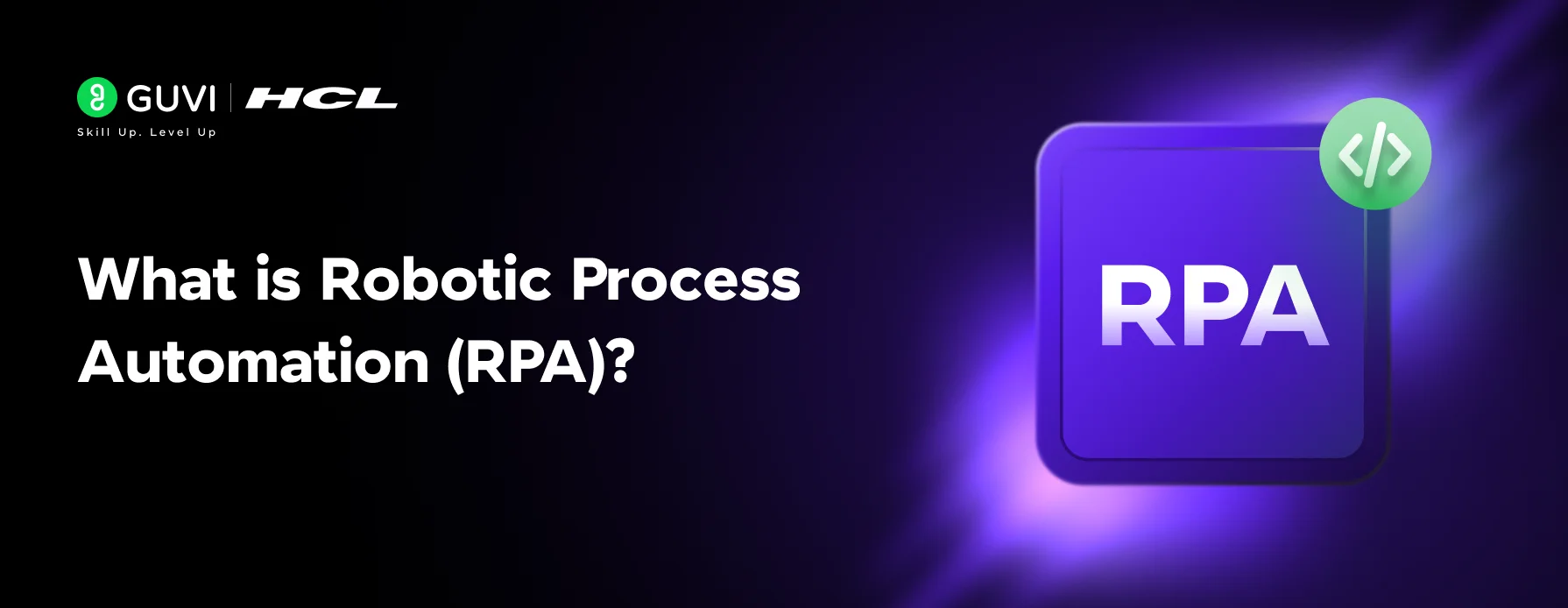
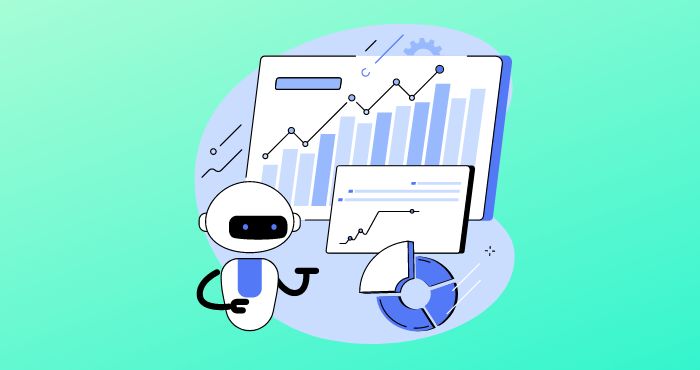
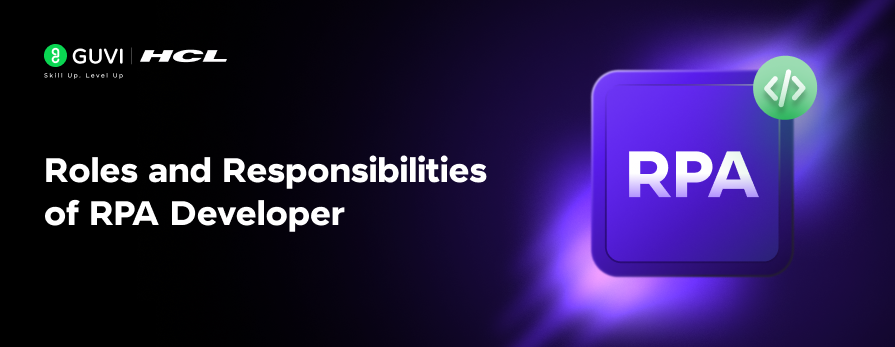

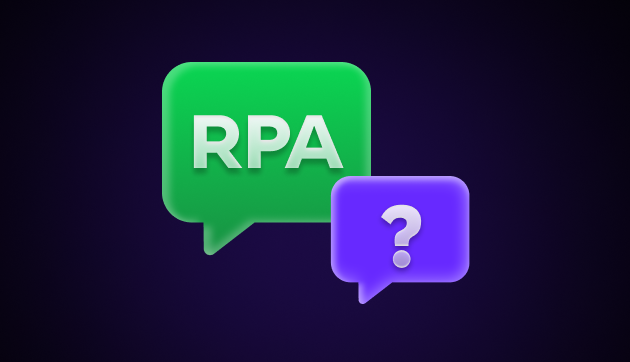



Did you enjoy this article?